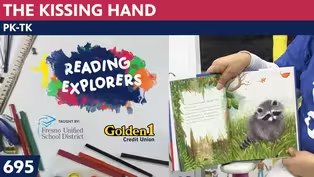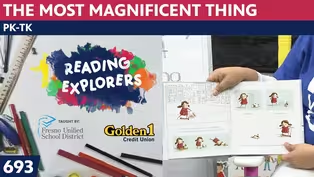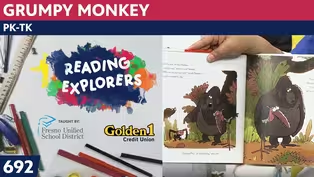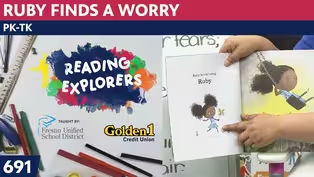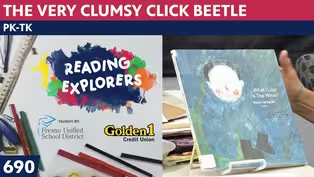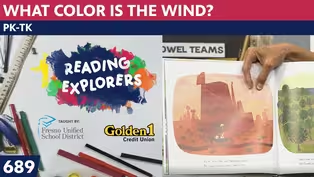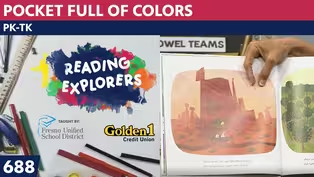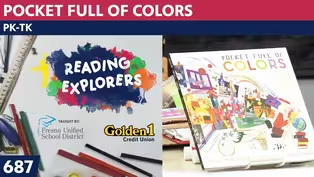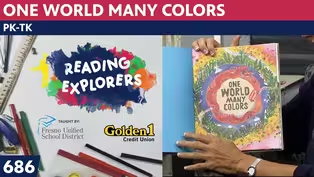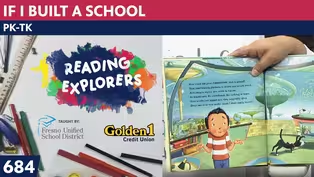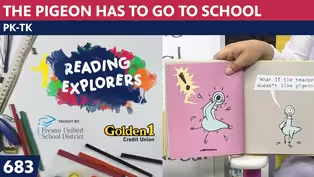
TK-363: Breaking Waves by Claude Monet
Season 3 Episode 349 | 14m 14sVideo has Closed Captions
Join Mrs. Readwright at Camp Discovery!
Join me today as we continue our Earth Day celebration week. Each day we will introduce masterpieces that illustrate a part of our beautiful planet Earth . Four days this week, we will work on one project...adding another part of the earth. We will create the land, water, air and outer space. Today we have Breaking Waves by Claude Monet. If you would like to make artwork that shows oceans.
Problems playing video? | Closed Captioning Feedback
Problems playing video? | Closed Captioning Feedback
Reading Explorers is a local public television program presented by Valley PBS

TK-363: Breaking Waves by Claude Monet
Season 3 Episode 349 | 14m 14sVideo has Closed Captions
Join me today as we continue our Earth Day celebration week. Each day we will introduce masterpieces that illustrate a part of our beautiful planet Earth . Four days this week, we will work on one project...adding another part of the earth. We will create the land, water, air and outer space. Today we have Breaking Waves by Claude Monet. If you would like to make artwork that shows oceans.
Problems playing video? | Closed Captioning Feedback
How to Watch Reading Explorers
Reading Explorers is available to stream on pbs.org and the free PBS App, available on iPhone, Apple TV, Android TV, Android smartphones, Amazon Fire TV, Amazon Fire Tablet, Roku, Samsung Smart TV, and Vizio.
Providing Support for PBS.org
Learn Moreabout PBS online sponsorshipMore from This Collection
Valley PBS and Fresno Unified School District have partnered with Golden 1 Credit Union to create Reading Explorers Lessons for grades Pre-Kindergarten through Third grade. The daily lessons will be taught by Fresno Unified School District teachers and are created to help students practice their reading skills and reinforce lessons during distance learning.
Video has Closed Captions
Valley PBS presents Reading Explorers Lessons for Pre-Kindergarten and TK. (26m 27s)
PK-TK-693-The Most Magnificent Thing
Video has Closed Captions
Valley PBS presents Reading Explorers Lessons for Pre-Kindergarten and TK. (26m 26s)
Video has Closed Captions
Valley PBS presents Reading Explorers Lessons for Pre-Kindergarten and TK. (26m 28s)
Video has Closed Captions
Valley PBS presents Reading Explorers Lessons for Pre-Kindergarten and TK. (26m 28s)
PK-TK-690: The Very Clumsy Click Beetle
Video has Closed Captions
Valley PBS presents Reading Explorers Lessons for Pre-Kindergarten and TK. (26m 22s)
PK-TK-689: What Color is the Wind?
Video has Closed Captions
Valley PBS presents Reading Explorers Lessons for Pre-Kindergarten and TK. (26m 21s)
PK-TK-688: Pocket Full of Colors
Video has Closed Captions
Valley PBS presents Reading Explorers Lessons for Pre-Kindergarten and TK. (25m 58s)
PK-TK-687: Dancing Through Fields of Colors
Video has Closed Captions
Valley PBS presents Reading Explorers Lessons for Pre-Kindergarten and TK. (26m 20s)
PK-TK-686: One World Many Colors
Video has Closed Captions
Valley PBS presents Reading Explorers Lessons for Pre-Kindergarten and TK. (27m 13s)
PK-TK-685: School is Wherever I am
Video has Closed Captions
Valley PBS presents Reading Explorers Lessons for Pre-Kindergarten and TK. (26m 32s)
PK-TK-684: If I Built a School
Video has Closed Captions
Valley PBS presents Reading Explorers Lessons for Pre-Kindergarten and TK. (26m 21s)
PK-TK-683: The Pigeon Has to Go to School
Video has Closed Captions
Valley PBS presents Reading Explorers Lessons for Pre-Kindergarten and TK. (26m 22s)
Providing Support for PBS.org
Learn Moreabout PBS online sponsorship(guitar music) ♪ Good morning to a brand new day ♪ ♪ Time to learn and games to play ♪ ♪ Learning things is so much fun ♪ ♪ Learning is good for everyone ♪ (playful music) - Hello, early learners!
It's Mrs. Readwright.
Welcome back to the art room.
We're celebrating Earth Day Week, and we know that we have been doing the same project each day with the same material.
So you can just keep it all in one place and bring it out each morning when we meet together.
Let's do our good morning song about the duck.
Ready, I like to start with a great big oh.
♪ Oh ♪ Ready?
♪ Oh, the duck says quack ♪ ♪ And the cow says moo ♪ ♪ And the old red rooster says cock-a-doodle-doo ♪ ♪ The sheep says baa and the cat says mew ♪ ♪ And I say good morning when I see you ♪ Good morning.
Alrighty.
So, our project around Earth Day is creating an Earth that's out in outer space.
And we started out with the mountains.
We moved on to the hills and trees.
And today, we're going to be doing the water.
Oh, get up here, table.
A nice friend from the studio brought me a different kind of table to use.
But I was so afraid when I leaned on it, I might break it because I'm getting so excited about my artwork.
Let me take a look at this.
Yep, I got the forest started.
There's a lot more to do.
But I wanted to tell you about the artist for today.
We need to add our river, and then we need to add our ocean today.
Those, both of those waterways.
So I brought a painting today called "Breaking Waves" by Claude Monet.
Now we know Claude Monet loved doing all of those water lilies.
And as a matter of fact, next week, the T-K classes are learning about Monet and the water lilies.
So I'm going to do the water lily study all next week.
So, be ready.
But Claude Monet, let's remember about him.
When he was an artist, at that time, they did not have tubes of paint when he first started.
So it wasn't easy to take your paints outside and paint in the en plain air.
So what we knew about Claude Monet was that he did all of his work inside the studio until it became more portable.
And portable means it can be taken around, like, traveled around with.
So when he went out to his lily pad pond, he could paint the colors that he saw and the light.
He could paint things look realistic.
Well, this painting, "Breaking Waves," he actually got to do out by the ocean.
Because after a while, they learned to put the paints into tubes or into containers that could be taken in a backpack or in some kind of cart out to where they wanted to paint.
So this, it shows the horizon line.
Remember that's where the land meets the sky or where the water meets the sky.
So in the foreground, we can see that his swirling waves are all churning up like they do, especially if after they've hit rocks that are near the shore.
It'll break up the waves and make them all splashy and make them wave this way.
Back here, it's calmer out in the ocean.
So I'm going to use that as my inspiration for doing my river.
Now, the river I'm going to do like theirs is.
I really liked their idea of making swirls in, around and around.
And the waves will be peaks of waves with swirls in there.
And this spirals like we learned to do with Klimt.
So, what we're going to do right now is go to our paper.
I'm using my black permanent pen to go around the place where I'm going to do my river and then where I'm going to do my ocean.
So get yourself set up and let's get started drawing our next step of our picture.
Okay.
Now, I have my white paper, and I'm facing it to myself right now, boys and girls.
'Cause I kind of want to see how far down I want to make my river.
And I'm going to make it kind of curved, not big curves like waves, but make it so that I can decide where I'm going to stop doing my forest.
Because you know, I will finish this over the weekend and bring it back to show you.
Now, I'm going to make the ocean waves waving up, waving up, waving up.
Different heights, I think will make it interesting.
There.
And then I can go here and do a different direction with smaller waves.
Smaller waves, smaller waves, smaller waves, smaller waves.
And you know, if you don't feel like doing these waves, you don't have to, this is your project.
I'm going to do my spiral of the river.
Some rivers go really fast.
Some rivers are kind of slower.
So you can decide how you might want to do spirals.
And maybe you won't even do spirals.
Who knows?
You might just decide to do little tiny waves in the river.
If you've ever gone fishing, they sometimes just have these little dips in the water.
Maybe I'll do that, few of them.
But I really do like the look of the spiral.
Some of them I'm starting going up.
Some I'm starting going down.
You decide how you want your river to look and how you want your ocean to look.
I'll do a little one right here.
Maybe some little waves around.
I'm so glad there's no one over my shoulder telling me, "Oh, add some more there, Ms. Readwright.
You need to put something there."
Because you know my feeling about that.
I keep trying to tell people, because I know sometimes our families want our work to look a certain way.
But when we talk about our art, it is not for someone else to tell us, unless you're in a art class and the teacher is telling you, "Oh, we need to learn to do this kind of stroke," or "I need you to use this kind of material."
That's different.
But when you're doing your own art just for pleasure, you just decide what you want.
And I think I might even put a little fish like they did.
You know, how they made an oval and then made the tail.
I'm making my tail kind of fancy.
And I don't want him to be alone, so I'll put another fish down at this end.
Do you need to put a fish?
You decide, I don't know what you want on your picture.
They even put starfish on theirs.
But now I'm going to paint this in.
And just like other places I told you, it's best to make your colors mixtures of colors so they don't just look like you've got your paints out from your school desk, and just decided to paint it straight from the little pan.
And how I do it is I get the color, and I can mix it up in the lid of my paint tin.
It's really not a tin, but it's my paint box.
'Cause some, in the old days, they did have all metal ones.
But I think they found out it got really rusty.
Now, in order for this to be kind of a watery place, I need to put quite a bit of water.
I think I'm going to do my river a lighter blue, and my ocean, a darker blue.
So let me move this light blue up.
And I even have a lighter blue in another box of paints.
I think I'll bring it over too.
I hope I don't drip it on this chair.
Oh, yeah, I like this.
And I might go around my spirals.
That's what I'll do.
I'll go around my spirals with one color and then come back in with the other color.
I like that idea.
Maybe you'll like that idea too, I don't know.
Maybe I should get out a brush that's more rounded because what I'm doing is bumping into it each time I go to use it.
So I've gotta get my dark blue, get it loaded up on my brush, and go around, and make each of these that color.
Mm-hmm, I think this makes it fancier for myself.
I like that.
And it doesn't have to be right on top of the pen.
I'm going to go beside it.
By the time I get to the end, it might be dry enough to go back over it with the lighter blue.
What do you think?
Is that what you you're thinking?
If you go all the way across your paper and come back, it will have a drier place, and you won't mix up your colors as much?
And while my brush is still kind of wet, I could go back up in here into the sky and give it a little sky color, stay away from my mountains.
But I don't need to worry about that right now 'cause I can come back to this and do it at my house when I take it home.
I'll finish up around here.
Then I can come back with another brush that I think will make it even a lighter blue and really pretty.
So I'm going to get it in the paints and go in between.
Oh, look how that mixes up and goes over that darker blue.
And it mixes in with the lighter blue, getting near my ocean color.
I'm gonna see what it looks like next to the ocean, if I think that this is a good combination.
You know, you can just try it out and say, "Oh, that didn't look so good.
So maybe I'll do it a different color."
And you can change it all you want.
I'm keeping mine kind of wet so that it makes it look like water.
Gonna get my ocean color.
I might even put some greens in my ocean color.
'Cause if you've ever been out to the ocean, and you see that it's mixing in, oh, that's pretty.
Okay.
All right.
I like the way that looks.
The blue and the green mixed together makes a pretty good ocean-y color.
And maybe I should leave the tips a little bit white because you know how when the tips of the ocean wave goes up, it's kind of white.
I do have some white paint over on my table that I thought, "Oh, I could use it to do my sky and put clouds in the sky after I painted it."
But maybe I even want it to do it in my ocean at the ocean wave tips.
I'll leave it open a little bit.
Oh, maybe not.
I'll paint over the top with that paint because that paint is thicker.
And I can get in there and make the white paint cover over any paint that I wanted to make sure that gets on the tip of the waves.
Maybe after I do some of my ocean, I can do this.
Getting it in that little space there.
Because the bottom one, I'm going to do a completely different color.
Maybe I'll do it all just this blue, a light, light one.
Boys and girls, tomorrow, remember I made the correction, is Earth Day.
And if you've been cutting out magazine colors now.
What happens if you don't have magazines that you can tear up?
You can find old pieces of blue and green paper in the ads, the food ads, and you can tear those up.
Or if you want to just color it, it will be fine.
'Cause we're just doing a model of the Earth.
And you'll see why I'm doing the Earth Day project so that you can then hang it on your door, so people know that you care about the Earth and you're being careful with all of the things, so that you pick up trash and treat the soil, and the air, and the water in a kind way.
So tomorrow you'll bring a piece of white paper and your pieces of green, blue, and black from your ads or from your magazines, so that we can make a model of the Earth.
I'm liking how this is turning out very much, boys and girls.
Alrighty.
So, Earth Day and Earth Day art.
Let me put this aside and get ready to say goodbye to you.
Do you remember the verse of the "Boom-de-ah-da"?
We can say that.
We'll boom-de-ah-da right into our "Oh, It's Time to Say Goodbye to All Our Friends."
♪ Boom-de-ah-da, boom-de-ah-da ♪ ♪ Boom-de-ah-da, boom-de-ah-da ♪ ♪ Boom-de-ah-da ♪ ♪ Oh, it's time to say goodbye to all my friends ♪ ♪ Oh, it's time to say goodbye to all my friends ♪ ♪ Oh, it's time to say goodbye ♪ ♪ Give a smile and wink your eye ♪ I'll see you tomorrow on Earth Day.
(guitar music) ♪ Good morning to a brand new day ♪ ♪ Time to learn and games to play ♪ ♪ Learning things is so much fun ♪ ♪ Learning is good for everyone ♪
Support for PBS provided by:
Reading Explorers is a local public television program presented by Valley PBS
